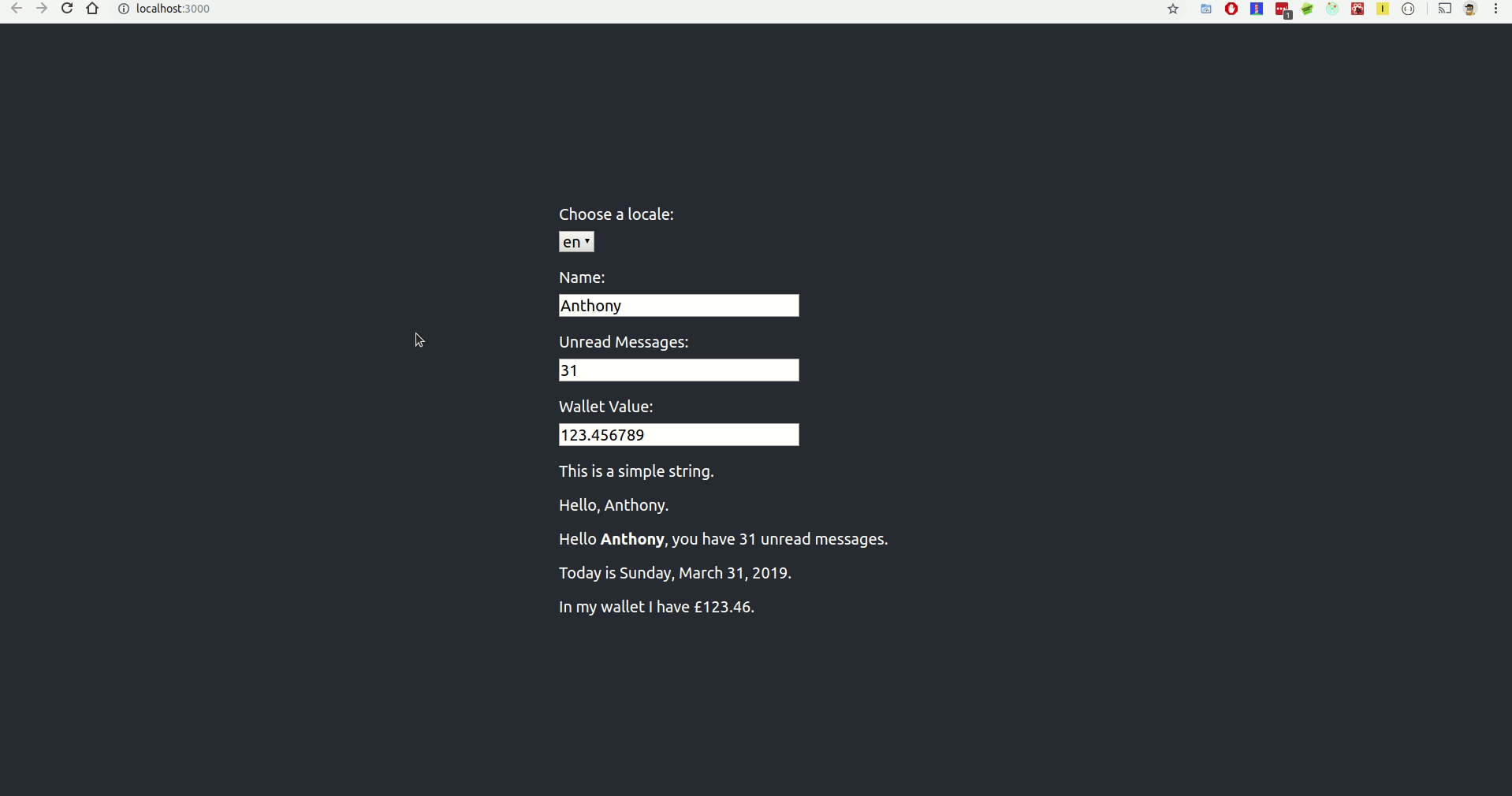This repository showcases how react applications can make use of react-intl to aid with interationalization, and cater for numerous languages / regions. Examples contained within showcase:
- Dynamically loading i18n polyfills per locale as required.
- Linting translation components to enforce consistency in their implementation.
- Adding simple translations.
- Interpolating translations with dynamic values.
- Handling translations containing plurals.
- Using syntax that allows for switch statement like translations.
- Displaying numeric values as currency.
- Converting timestamps into human-readable dates.
- Wrapping substrings of translations with HTML.
This project assumes you already have Node and Yarn installed. The steps are as follows:
- Install node dependencies:
yarn install- Run the application:
yarn start- Use the form controls to change locales, and update dynamic values to refresh translations.
Translations can be extracted from source code along with their development ID's, default messages and translator descriptions. This generates a specially formatted template that can then be uploaded into Translation Management Systems (TMS) in order to have a professional translator localise the messages into a particular language. The completed file could then be downloaded and compiled back into a format that react-intl understands, as a locale specific file.
To illustrate this, two scripts have been added:
yarn run translations:extract
yarn run translations:compileThe extract command will creates the src/translations/_extracted-template.json file. For illustrative purposes, I've created a dummy file (src/translations/_translated-de-template-from-translator.json) that mimics the template as having been localised into German, and passed back. Running the compile command will parse this file and output the german translation file (src/translations/de.json).
Almost every modern browser has a fully implemented Intl API which makes it difficult to test polyfills. You can update the source code so that at some stage during runtime, the PluralRules constructor is removed:
delete window.Intl.PluralRulesNow when reloading the project, you can see in the network panel a core plural rules polyfill is downloaded, followed by plural rules for the current locale. Changing the locale via the form control will show a spinner while downloading the new locales plural rule data.
Internationalization (i18n) is the process of getting an application ready to handle multiple languages (e.g. database charset migrations, implementing translation libraries and wrapping source strings, designing UI to be fluid and capable of handling varying amounts of text content).
Localization (l10n) is the process of incorporating another locale / language into your application by adding new translation files, options to language dropdowns etc.
Translation files work by matching a key to a translation but this key often appears in two forms:
-
Default Language - This is often the easier path to take, as it means you won't need a translation file for your default language. Disadvantages are that you lose context of where the translation is being placed, and context could alter the translation. For example, single-word translations like "Next" or "Continue" can occur at various places within the application (e.g. labels, buttons, tab names etc) but might have very different meaning or gender connotations depending on their placement. The literal translation to another language might be very inappropriate.
-
Namespace - Developer defined namespaces (e.g.
navigation.links.contact) are language agnostic and can give more context to allow translators to choose a more appropriate translation. Some trade-offs are that the default language will need a translation file (as keys are not appropriate to show the end user), and that the translator will need to refer to an accompanying description, design or project document where they can see the default language version, as it can't always be derived from the namespace.
Based on the above, namespaces are the preferred method as they:
- Allow for multiple translations of the same word or phrase (to account for various contexts it may be used within).
- Ensures consistency by forcing the default language to be treated like every other language, and require a translation file.
- Allows for logical grouping within the translations file e.g. header translations, navigation translations and page by page translations.
- Ensures a generally standard length of key compared to using the default language directly (a particular translation could be translating an entire paragraph).
Plural rules offer a way of representing how a language handles various cases of quantity, such as having zero, one or many of something. These cases often differ greatly from language to language.
Example: In English, zero is considered plural (e.g. 0 messages), but in French, zero is considered singular (e.g. 0 message).
You have {unreadMessages, plural, one {# unread message} other {# unread messages}}.
Translations are not always simple, static strings. Often they are required to dynamically craft their final result by matching a value to one of many choices. Much like a switch statement, this is done by matching a value to supplied translations.
Example: A translation may require gender context and will differ due to the need for a varying pronoun (e.g. "He took the car.", "She took the car.", "They took the car.").
{gender, select, male {He} female {She} other {They}} took the car.
Example: Rather than handling conditional logic in your application code to show related messages as separate translations, this could be handled by associating those outcomes into a single translation:
{isTaxable, select, yes {An additional tax will be collected.} other {No taxes apply.}}
